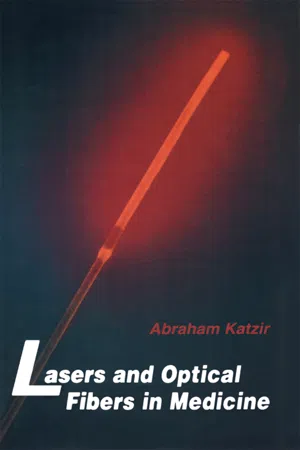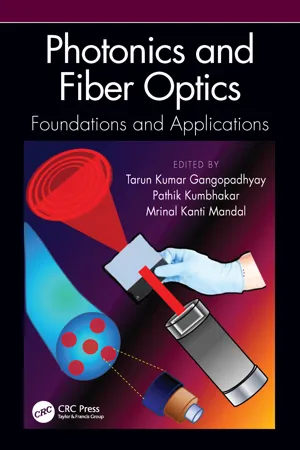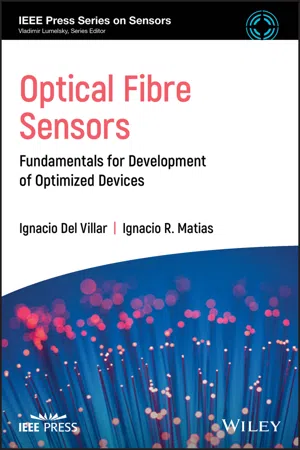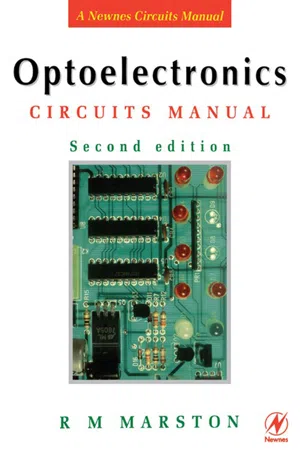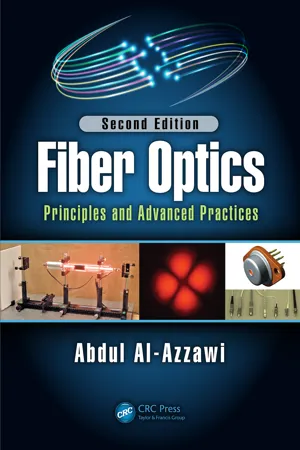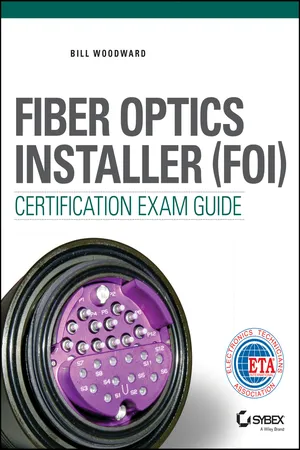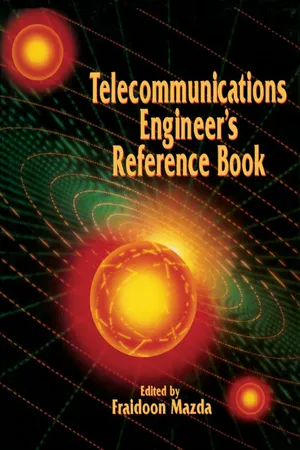Physics
Fibre Optics and Endoscopy
Fiber optics is a technology that uses thin, flexible glass or plastic fibers to transmit light and carry information. In endoscopy, fiber optics are used to illuminate and visualize the inside of the body, allowing for minimally invasive medical procedures. This technology relies on the principle of total internal reflection to guide light through the fibers, enabling high-resolution imaging.
Written by Perlego with AI-assistance
Related key terms
Related key terms
1 of 4
Related key terms
1 of 3
9 Key excerpts on "Fibre Optics and Endoscopy"
- eBook - ePub
- M.L. Anand(Author)
- 2021(Publication Date)
- CRC Press(Publisher)
25 Fibre Optic Communication The Fiber optic communication is the science of transmitting data, voice and images by the passage of light through thin, transparent fibres. It is also spelt as fiber optics. In telecommunication, fibre optic technology has virtually replaced the copper wire in long distance telephone lines and it is used to limit computers within local area network (LAN). The basic medium of fibre optics is a hair-thin fibre that is sometimes made of plastic, but more often of glass. A typical glass optical fibre has a diameter of 125 micrometers or 0.125 mm (0.005 inch). This is actually the diameter of the cladding or outer reflecting layer. The core or inner transmitting cylinder, may have a diameter as small as 0.10 mm. Through a process called total internal reflection, light rays beamed into the fibre can propagate within the core for great distances with remarkably little attenuation or reduction in intensity. The degree of attenuation over distance varies according to the wavelength of the light and composition of the fibre. When glass fibres of core/cladding design were introduced in early 1950s the presence of impurities restricted their employment to short lengths. In 1960 Electrical engineers working in England suggested using fibres for telecommunication, and within decades, silica glass fibres were being produced with sufficient purity that infrared light signals could travel through these for 100 km (60 miles) or more without having to be boosted by repeaters - No longer available |Learn more
Fiber Optic Sensors
An Introduction for Engineers and Scientists
- Eric Udd, William B. Spillman, Jr.(Authors)
- 2011(Publication Date)
- Wiley(Publisher)
Chapter 16 Fiber Optic Biosensors William B. Spillman Jr. Columbia Gorge Research, Fairview, Oregon 16.1 IntroductionThe advantages of fiber optic technology have long been appreciated by the biomedical and biotechnology communities. Optical fibers are dielectric and nonconductive, biocompatible, flexible, small in size, and immune to electromagnetic interference. They can also be sterilized using standard medical sterilization techniques. Their initial and still most successful biological/biomedical application has been in the field of endoscopic imaging. More recently, they have been utilized to sense other parameters of interest to the biomedical and biotechnology fields.16.1.1 EndoscopyThe use of fiber optic bundles for imaging has revolutionized medicine. Prior to the development of such devices, the only method of inspecting the interior of the body was through invasive surgery. Now such devices are commonplace and are used for both in-vivo inspection/imaging and illumination. Before the introduction of these devices, there was no way to rapidly determine the presence of tumors, damaged or diseased tissue, and internal bleeding in the lungs, esophagus, stomach, or intestines, making diagnosis and treatment for such problems difficult and often erroneous. Many people owe their lives today to the existence of endoscopes. They are fabricated from high-quality glass optical fiber bundles. Unfortunately, their relatively high cost, which has remained constant for a long period of time, renders them inaccessible to the developing world with the consequence that medical care remains at levels not seen in the West since early in the twentieth century. Development of a lower-cost endoscope for the developing world represents a new product opportunity that will be discussed later. - eBook - ePub
- Abraham Katzir(Author)
- 2012(Publication Date)
- Academic Press(Publisher)
Research and development are being conducted in both research institutions and the large industrial laboratories. Concurrently, other applications of optical fibers have also been rapidly developed, including various types of diagnostic procedures. Optical fibers can also transmit high-power laser beams for laser therapy inside the body. Special optical fibers have been developed for transmitting optical radiation either in the ultraviolet (UV) or in the middle and far infrared (IR). This progress has had a great impact on the field of fiberoptics in medicine. First and foremost was the use of better fibers for endoscopy, which resulted in higher-resolution images with near-perfect color rendition and improved mechanical properties. Simultaneously, new fiberoptic techniques paved the way for using optical fibers in systems such as laser catheters or laser endoscopes (Katzir, 1991 and 1992). The development of optical fibers is a culmination of many decades of research and development that was conducted by a plethora of scientists and engineers. Yet it must be mentioned at this point that nature was already using this phenomenon millions of years ago. Biologists discovered that some tissues of plant seedlings act like optical fibers that guide light, helping the plants to coordinate their physiology. In the animal world, there are optical guiding phenomena in imaging systems such as the eyes of many animals, including the human eye. Finally there are reports that UV-transmitting or IR-transmitting optical fibers also appear in nature (see Section 4.7). 4.3 OPTICAL FIBERS—FUNDAMENTALS When light travels from air into water or glass, a small fraction of the light is reflected back into the air, while the rest is transmitted into the water or glass. These phenomena are called external reflection and refraction - eBook - ePub
Photonics and Fiber Optics
Foundations and Applications
- Tarun Kumar Gangopadhyay, Pathik Kumbhakar, Mrinal Kanti Mandal(Authors)
- 2019(Publication Date)
- CRC Press(Publisher)
Figure 3.1 . It consists of three main components: optical transmitter, communication channel and optical receiver. Optical communication systems may be classified into two categories: guided and unguided. Optical fibers are used in guided optical communication systems. Unguided optical systems have some specific applications in sensing and detecting systems but are not suitable in broadcasting systems like microwaves because optical beams spread mainly in the forward direction. Fiber optics is basically a part of optics or photonic engineering that mainly concentrates with the study of the propagation of light (rays or modes) through transparent di-electric waveguides, e.g., optical fibers. Fiber optic systems were deployed worldwide in around 1980 and have indeed revolutionized the telecommunications industry. The objective of this chapter is to explain the basic concept of optical fiber, wave guiding principle in optical fiber, working principle of some optoelectronic devices and optic communication systems in detailed and lucid manner.FIGURE 3.1Block diagram of an optical communication system.3.2 Evolution of Optical Communication Systems
The term fiber optics was first coined by N. S. Kapany in 1954 when he along with his colleagues at Imperial College of Science and Technology, London, developed an image transmitting device called the flexible fiberscope [1 ]. This newly discovered device soon found application in inspecting the inaccessible points inside the reactor vessels and jet engine. Presently the improved version of this device is being used for micro-surgery and different medical diagnosis and surgical applications.The next major breakthrough in this field came when T. H. Maiman demonstrated the use of pulsed ruby laser [2 ] in 1960 and the realization of the first semiconductor laser [3 ] in 1962 by different research groups working almost independently at various research laboratories. However, it took another eight years for the laser diodes to come into application and to be practically realizable in the communication industry. Around the same period another interesting development was noticed when Charles Kao and Charles Hocklam, working at the Standard Telecommunications Laboratory in England, proposed in 1966 that an optical fiber might be used as a communication medium, provided that the signal loss could be minimized and limited to or less than 20 db/km [4 ]. In 1970, Robert Maurer, Donald Keck and Peter Schultz of Corning Glass Corporation, USA, succeeded in producing a pure glass fiber which exhibited an attenuation of less than 20 db/km [5 ]. Concurrent developments in optoelectronic devices ushered in the era of fiber-optic communication technology. The communication techniques have been developed one after another in successive optical windows (three shaded regions) having minimum optical loss as mentioned in Figure 3.2 - eBook - ePub
Optical Fibre Sensors
Fundamentals for Development of Optimized Devices
- Ignacio Del Villar, Ignacio R. Matias(Authors)
- 2020(Publication Date)
- Wiley-IEEE Press(Publisher)
5 ] in its original format to perform specialized precise measurements of surface finish. The fibre endoscope, however, while certainly still used, also exemplifies the impacts of changes over half a century in technological development. Some endoscopic examinations now involve a remote CCD camera on a lead, and the ‘endoscopic pill’, embracing energy supply, radio transmitter for Wi‐Fi linkages and camera has also proved its efficacy. This very brief discourse exemplifies much of the background towards the modest penetration of fibre‐optic sensing overall especially from the perspective of the absolutely critical final operator, whose interests are in obtaining reliable information fitted to the technical and financial needs of the application, regardless of technological novelty. We need to recognize not only the fibre‐optic sensor itself but also the consumers' needs and impacts of other rapidly improving technologies, both complementary to the fibre sensor evolution and competing in cost–performance ratio.First of all, it is useful to reflect on what a fibre sensor actually is and relate this to the user that the sensor might want. Figures 14.1 and 14.2 attempt to summarize this. There is, of course, the sensor head itself within which light emanating from the input source is modulated in one of its many properties – phase, intensity, spectral distribution, polarization state, etc. – and thereafter hopefully retains this modulation until it is detected. The light should ideally be modulated only by the parameter of interest, but in reality there will almost always be interfering phenomena. Finally, the end user seeks an answer that is often along the lines of ‘yes, everything is fine’ or ‘maybe there are problems’. For the latter further detail may be required. Additionally, the user needs to be assured that the sensor system meets all the necessary regulatory and operational requirements. All this is glaringly obvious but often forgotten. Indeed, most of the preceding chapters focus entirely upon the modulation zone and often seek to highlight one particular measurement rather than considering interfering phenomena, optical input, transmission, and detection requirements. The key to this is that everything involving all the many interfaces needs to be stable throughout the operating regime of the sensor system. Figure 14.2 illustrates one of the major potential (and often realized) benefits of fibre sensors – namely, the ability to sense many points simultaneously, either through arrays of extrinsic sensors or through the single intrinsic sensor shown for distributed measurements. Either format can function over lengths of many tens of kilometres, but again the factors mentioned above must all be taken into account – sometimes a major challenge! For the occasional cooperative measurand, self‐correction can be accomplished [6 - eBook - ePub
- R M MARSTON(Author)
- 1999(Publication Date)
- Newnes(Publisher)
10Fibre optics and lasers
The two most revolutionary and important optoelectronic-associated events to have occurred since the mid-1960s are the development of practical fibre optic cables for use in interference-free wide-band communication systems, and the development of reliable long-life low-cost laser units for use in everyday gadgets such as CD-players and bar-code readers. The first half of this chapter explains the basic operating principles and applications of fibre optics; the second half gives similar treatment to LEDs and lasers.Fibre optics
IntroductionA fibre optic cable can, in very simple terms, be regarded as a hair-thin flexible light pipe or optical waveguide that can efficiently carry modulated or unmodulated light signals from one point to another (even if the journey involves bends and loops) with complete immunity from electromagnetic interference. In most practical applications the cable must be linked to the light source and destination points via special connectors, to minimize signal losses.Figure 10.1 shows the basic elements of a simple one-channel one-way fibre optic communication system, in which the output of the optogenerator LED is pulse-modulated and is coupled to the input of optosensor Q1 and its pulse-detecting unit via a length of sheathed fibre optic cable.Figure 10.1 Simple single-channel 1-way fibre optic communication systemThe Figure 10.1 circuit can send data from point A to point B, but not the other way around. Figure 10.2 - eBook - ePub
Fiber Optics
Principles and Advanced Practices, Second Edition
- Abdul Al-Azzawi(Author)
- 2017(Publication Date)
- CRC Press(Publisher)
1 Fibre-Optic Cables 1.1 INTRODUCTIONFibre-optic cables transmit data through very small cores at the speed of light. Significantly different from copper cables, fibre-optic cables offer high bandwidths and low losses, which allow high data-transmission rates over long distances. Light propagates throughout the fibre cables according to the principle of total internal reflection.There are three common types of fibre-optic cables: single-mode, multi-mode and graded-index (GRIN). Each has its own advantages and disadvantages. There are also several different designs of fibre-optic cables, each made for different applications. In addition, new fibre-optic cables with different core and cladding designs have been emerging; these are faster and can carry more modes. Although fibre-optic cables are mostly used in communication systems, they also have established medical, military, scanning, imaging and sensing applications. They are also used in optical fibre devices and fibre-optic lighting.This chapter will discuss the fabrication processes used in manufacturing fibre cables. The processes produce a thin flexible glass strand with a diameter even smaller than that of human hair. This chapter will also detail methods of coupling a light source with a fibre cable in the manufacturing of optical fibre devices. It will also compare fibre and copper cables and describe the applications of fibre-optic cables in many fields and sectors of modern society. Finally, this chapter will present four experimental cases, including fibre cable inspection and handling, fibre cable end preparation, numerical aperture measurements and calculations and fibre cable power output intensity measurements and calculations.1.2 THE EVOLUTION OF FIBRE-OPTIC CABLESThe evolution of optical communication systems dates back to the early 1790s, when the French engineer Claude Chappe (1763–1805) invented the optical telegraph. His system involved a series of semaphores mounted on towers, where human operators relayed messages from one tower to the next. This was certainly an improvement over hand-delivered messages. But by the mid-nineteenth century, the optical telegraph was replaced by the electric telegraph, leaving behind a legacy of Telegraph Hills, San Francisco. - Bill Woodward(Author)
- 2014(Publication Date)
- Sybex(Publisher)
Chapter 1 History of Fiber Optics and Broadband AccessThe following ETA Fiber-Optics Installer competencies are covered in this chapter:
- Trace the evolution of light in communication.
- Summarize the evolution of optical fiber manufacturing technology.
- Track the evolution of optical fiber integration and application.
- Describe the role of fiber optics in high-speed Internet access.
Like many technological achievements, fiber-optic communications grew out of a succession of quests, some of them apparently unrelated. It is important to study the history of fiber optics to understand that the technology as it exists today is relatively new and still evolving.This chapter discusses the major accomplishments that led to the creation of high-quality optical fibers and their use in high-speed communications and data transfer, as well as their integration into existing communications networks.In this chapter, you will learn to- Recognize the refraction of light
- Identify total internal reflection
- Detect crosstalk between multiple optical fibers
- Recognize attenuation in an optical fiber
Evolution of Light in Communication
Hundreds of millions of years ago, the first bioluminescent creatures began attracting mates and luring food by starting and stopping chemical reactions in specialized cells. Over time, these animals began to develop distinctive binary, or on-off, patterns to distinguish one another and communicate intentions quickly and accurately. Some of them have evolved complex systems of flashing lights and colors to carry as much information as possible in a single glance. These creatures were the first to communicate with light, a feat instinctive to them but tantalizing and elusive to modern civilization until recently.- eBook - ePub
- Fraidoon Mazda(Author)
- 2014(Publication Date)
- Butterworth-Heinemann(Publisher)
53Fibre optic communications
Takis Hadjifotiou and John McFarlane,Bell Northern Research Sections 53.1 –53.6);Northern Telecom (Section 53.7 )Publisher Summary
This chapter discusses THE analysis of communication through optic fiber. The propagation of light is governed by Maxwell’s equations but a good insight of the propagation in dielectric material can be gained through Snell’s law on refraction and reflection. The transmission point of view these can be reduced to essentially two, that is, attenuation and dispersion. The intrinsic losses are essentially two, that is, absorption and scattering. Fiber used in optical communications is made from glasses with high silica content doped with various oxides. Microbending loss is caused by pressure exerted by other fiber within a fiber cable. The dispersion of a fiber of arbitrary parameters can be separated into two elements, intramodal and modal. Optical sources made of semiconductors offers excellent performance both optical and electronic, small size and reliability. Population inversion is obtained in a semiconductor p-n junction by heavily doping both types of the material. The function of an optical detector is to recover the information which was imposed on the optical carrier and to recover the information imparted on one of the parameters of the optical carrier. The details of the design of optical receivers depend on the applications. The configuration of an optical transmitter depends first on the signal format and second on the class of the device (LED or laser). The coding of the transmitted information is used in coaxial systems to reduce the bandwidth and make it possible to increase the section length and as a result minimize the number of repeaters in a system.
Index pages curate the most relevant extracts from our library of academic textbooks. They’ve been created using an in-house natural language model (NLM), each adding context and meaning to key research topics.
Explore more topic indexes
Explore more topic indexes
1 of 6
Explore more topic indexes
1 of 4


